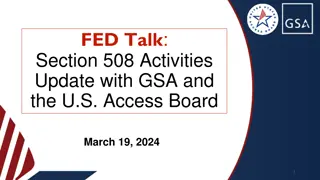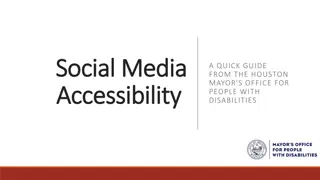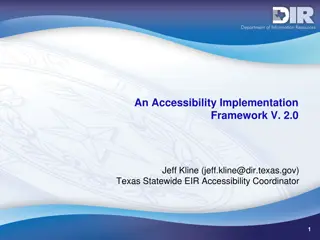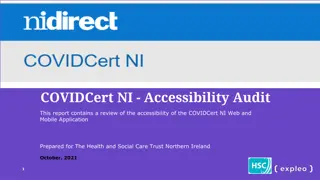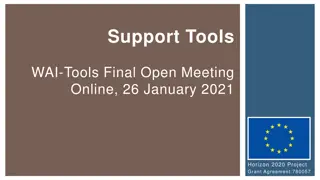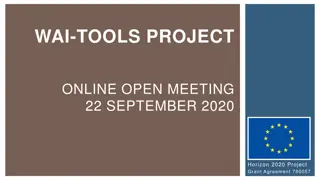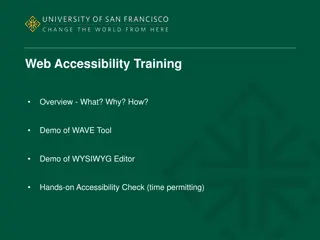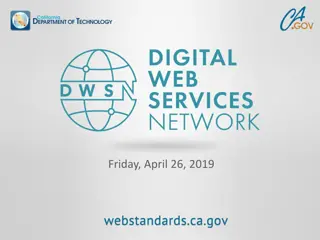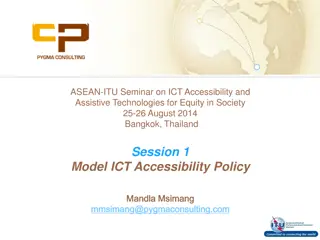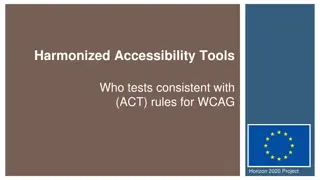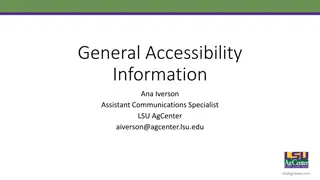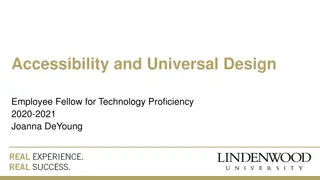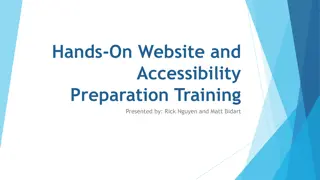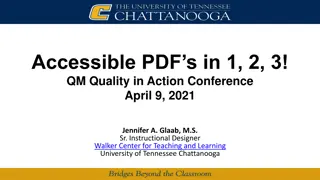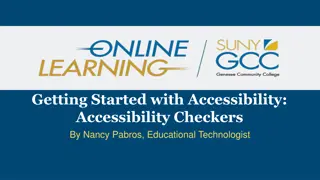AI for Student Accessibility: From Hurdles to Opportunities
Explore the power of AI and Universal Design in enhancing student accessibility. Learn how ChatGPT fosters interactive learning and discover AI-powered resources for self-directed student growth.
Download Presentation

Please find below an Image/Link to download the presentation.
The content on the website is provided AS IS for your information and personal use only. It may not be sold, licensed, or shared on other websites without obtaining consent from the author.If you encounter any issues during the download, it is possible that the publisher has removed the file from their server.
You are allowed to download the files provided on this website for personal or commercial use, subject to the condition that they are used lawfully. All files are the property of their respective owners.
The content on the website is provided AS IS for your information and personal use only. It may not be sold, licensed, or shared on other websites without obtaining consent from the author.
E N D
Presentation Transcript
From Hurdles to Opportunities: Unleashing the power of AI through the lens of Universal Design Heather Dill SLIDESMANIA.COM
Introduction HELLO! My name is Heather Dill, as an instructional technology coach and former special education teacher, I am excited to talk to you today about AI and chatbots increasing student accessibility through Universal Design.
Introduction to Universal Design for Learning and AI Universal Design for Learning (UDL) Accessibility for students with disabilities AI and ChatGPT s role in enhancing UDL implementation
Using ChatGPT to stimulate curiosity and interactive conversations 1. "ChatGPT, can you share a short story that teaches a lesson about kindness and empathy?" 2. "ChatGPT, what are some strategies for solving mathematical word problems involving real-life scenarios?" 3. "ChatGPT, can you describe the process of photosynthesis in simple terms?" 4. "ChatGPT, can you provide a step-by-step guide to creating a piece of art using a specific medium (e.g., watercolors)?" 5. "ChatGPT, what are the key features of a particular historical event (e.g., the invention of the printing press) and how has it impacted society? 6. "ChatGPT, what are some fun and interesting scientific experiments that students can do with everyday household items?" 7. "ChatGPT, can you recommend a variety of books or resources tailored to the interests and reading levels of students with disabilities?"
Encouraging self-directed learning with AI-powered resources 1. Brainly 2. Quizlet 3. GPT-based writing assistants 4. Duolingo 5. Cognii Virtual Learning Assistant 6. Wolfram Alpha 7. ALEKS (Assessment and Learning in Knowledge Spaces) 8. Symbaloo 9. Kami 10.MindMup 11.Khan Academy
AI powered resources teachers can use with students who have disabilities to encourage self-directed learning. 1. GPT-based tutoring systems: Platforms like Carnegie Learning's MATHia, Squirrel AI Learning, and Thinkster Math 2. Kurzweil 3000: 3. Bookshare: 4. Snap&Read Universal: 5. Cognii Virtual Learning Assistant: 6. Newsela: 7. Assistive Express: 8. ModMath: 9. Inspiration Maps: 10.Read&Write:
Engagement Turn to your table partners. Discuss how you might use the AI tools we just talked about or share some AI tools you may already use to increase engagement with individuals you work with. Padlet
ChatGPT Prompts to increase Representation 1. "Suggest strategies for adapting high-interest reading or writing activities to meet the needs of students with disabilities while maintaining engagement." 2. "Provide ideas for modifying hands-on activities or projects to ensure they are accessible and engaging for students with disabilities in a general education setting." 3. "Generate a list of assistive technology tools and resources that can be incorporated into lessons to support and engage students with disabilities." 4. "Offer recommendations for creating inclusive group activities and collaborative learning experiences that promote engagement and participation for students with disabilities." 5. "Provide strategies for incorporating Universal Design for Learning (UDL) principles into lesson planning to ensure content and activities are engaging and accessible for students with disabilities."
ChatGPTPrompts to increase Representation-1 1. "Suggest various methods for presenting information in multiple formats, such as visual, auditory, and kinesthetic, to cater to diverse learning preferences." 2. "Provide ideas for incorporating graphic organizers, mind maps, and other visual aids into lessons to help students with different learning styles better understand the content." 3. "Offer strategies for breaking down complex concepts into smaller, more manageable pieces to support students with varying levels of background knowledge and cognitive abilities." 4. "Generate a list of multimedia resources, such as videos, audio recordings, and interactive websites, that can be used to supplement traditional teaching methods and enhance representation." 5. "Recommend techniques for scaffolding and providing additional support to students who struggle with certain content areas, while maintaining engagement and promoting understanding."
Presenting information in multiple formats for diverse learning preferences 1. Immersive Reader (Microsoft) 2. Read&Write 3. Bookshare 4. Snap&Read Universal 5. Glean 6. Voice Dream Reader 7. Kurzweil 3000 8. NaturalReader 9. Seeing AI (Microsoft) 10.Rewordify 11.Google Lens Text-to-speech Interactive videos Visual aids Personalized learning
Leveraging multimedia and digital tools to support understanding 1. Edpuzzle: 2. Brainly: 3. Quizlet: 4. Immersive Reader (Microsoft): 5. Nearpod: 6. ThingLink: 7. Wolfram Alpha: 8. Glogster: 9. Cognii Virtual Learning Assistant: 10.Newsela: Gamification Interactive Simulations Digital Storytelling
Enhancing accessibility: making content accessible for students with visual, auditory, or cognitive impairments 1. Immersive Reader (Microsoft): 2. Seeing AI (Microsoft): 3. Ava: 4. Read&Write: 5. Voice Dream Reader: 6. Otter.ai: 7. Snap&Read Universal: 8. Glean: 9. SpeakIt!: 10.Assistive Express: Dyslexia-Friendly Text Audio Descriptions Alternative Text Multimodal Learning
Representation Turn to your table partners. Discuss how you might use the AI tools we just talked about or share some AI tools you may already use to increase engagement with individuals you work with. Padlet
ChatGPTPrompts to increase Action & Expression-2 1. "Suggest a variety of alternative assessment methods, such as presentations, videos, or portfolios, that allow students to demonstrate their learning in different ways." 2. "Provide ideas for incorporating creative expression and art-based activities into lessons, giving students the opportunity to express their understanding through various media." 3. "Offer strategies for incorporating choice and differentiation in assignments and assessments, allowing students to select the format or method that best suits their learning preferences and strengths." 4. "Generate a list of tools and technologies that can be used by students to create, collaborate, and communicate their understanding of content in innovative ways." 5. "Recommend techniques for scaffolding and providing additional support to students who struggle with traditional methods of expression, enabling them to better demonstrate their understanding and participate in the learning process."
ChatGPT Prompts to increase Action & Expression 1. "Suggest strategies for adapting assessments and assignments to accommodate the needs of students with disabilities while still allowing them to demonstrate their understanding effectively." 2. "Provide ideas for incorporating assistive technology tools and resources that can help students with disabilities express themselves and complete tasks more independently." 3. "Offer recommendations for designing group activities and collaborative learning experiences that promote inclusion and provide opportunities for students with disabilities to contribute and demonstrate their learning." 4. "Generate a list of modifications and supports that can be provided to students with disabilities during class activities and assessments to better accommodate their individual needs and strengths." 5. "Share strategies for implementing Universal Design for Learning (UDL) principles in planning lessons and activities to ensure that students with disabilities have equal opportunities to demonstrate their understanding and express themselves."
Offering choice in how students demonstrate their knowledge 1. Flipgrid 2. Pear Deck 3. GPT-based writing assistants: Tools like Grammarly or Writer 4. Book Creator 5. Cognii Virtual Learning Assistant 6. Padlet 7. MindMup 8. Sutori 9. Pobble 10.Quizizz
Encouraging self-assessment, reflection, and goal setting 1. Cognii Virtual Learning Assistant: 2. Socrative: 3. Quizlet: 4. ALEKS (Assessment and Learning in Knowledge Spaces): 5. GPT-based writing assistants: Tools like Grammarly or Writer 6. GoFormative: 7. Goalbook Toolkit: 8. Smart Sparrow: 9. Reflectly: 10.Seesaw:
Enhancing accessibility: accommodating different modes of expression and communication 1. Flipgrid: 2. Immersive Reader (Microsoft): 3. Read&Write: 4. Voice Dream Reader: 5. Assistive Express: 6. Otter.ai: 7. Snap&Read Universal: 8. GPT-based writing assistants: Tools like Grammarly or Writer 9. SpeakIt!: 10.Pear Deck:
Action & Expression Turn to your table partners. Discuss how you might use the AI tools we just talked about or share some AI tools you may already use to increase engagement with individuals you work with. Padlet
Practical Steps for AI Integration in the Classroom Selecting and evaluating AI tools for UDL implementation Training and support for educators using AI and ChatGPT Collaborating with special education professionals to enhance accessibility
More Practical Steps for AI Integration in the Classroom Addressing privacy and data security concerns Ensuring equitable access to AI- powered resources Encouraging responsible and ethical use of AI
Conclusion and Next Steps Recap of the benefits of integrating AI and ChatGPT in UDL implementation Call to action: incorporating AI-powered solutions to crate inclusive and accessible learning environments Resources for further exploration and professional development ISTE Future Tools Igniter.ai TopApps.Ai TinyWow Prompt Genie
Credits Presentation Template: SlidesMania Images: Unsplash. Novak UDL Guidelines ISTE




